Bed Exercises for Elderly: A Comprehensive Guide to Stay Active and Mobile


As we age, we need to focus on physical activity. We must maintain an active lifestyle. This becomes more important over time. Bed exercises can be a game-changer for elderly people. This is especially true for those with limited mobility. These exercises are simple but effective. You can do them from the comfort of your bed. They will help you stay strong, flexible, and independent.
Regular exercise offers many benefits for older people. It includes improved heart health, increased muscle strength, better balance, and enhanced well-being. By doing bed exercises daily, you can cut the risk of falls. You can also keep your independence and enjoy a better life.
In this guide, we’ll cover many bed exercises. The products are designed for elderly people. This exercise will help you achieve your fitness goals. You can do it from your bed. It’s great for recovering from an illness. It’s also good for facing mobility challenges or just trying to stay active.

Stretching Exercises
Stretching exercises are crucial. They maintain flexibility and range of motion. These can become limited as we age. Here are some gentle stretches you can perform while lying in bed:
Neck Stretches
Gentle Neck Rolls
Start by lying on your back with your feet flat on the bed and your knees bent. Slowly roll your head from side to side, allowing your neck to stretch gently. Repeat this movement several times in each direction.
Shoulder Shrugs
While lying on your back, inhale and raise your shoulders towards your ears. Hold for a few seconds, then exhale and release your shoulders. Repeat this exercise several times.
Arm Stretches
Overhead Reach
Lie on your back and extend one arm overhead, reaching as far as you comfortably can. Hold the stretch for a few seconds, then switch arms and repeat.
Cross-body Arm Stretch
Lie on your back and bring one arm across your body, using your other arm to pull it towards you gently. Hold the stretch for a few seconds, then switch sides.
Leg Stretches
Hamstring Stretch
Lie on your back and extend one leg straight up towards the ceiling. Loop a towel or band around the bottom of your foot. Gently pull your leg towards you. Feel the stretch in the back of your thigh. Repeat on the other side.
Calf Stretch
Lie on your back and loop a towel or resistance band around the ball of one foot. Gently pull your foot towards you, feeling the stretch in your calf muscle. Repeat on the other side.
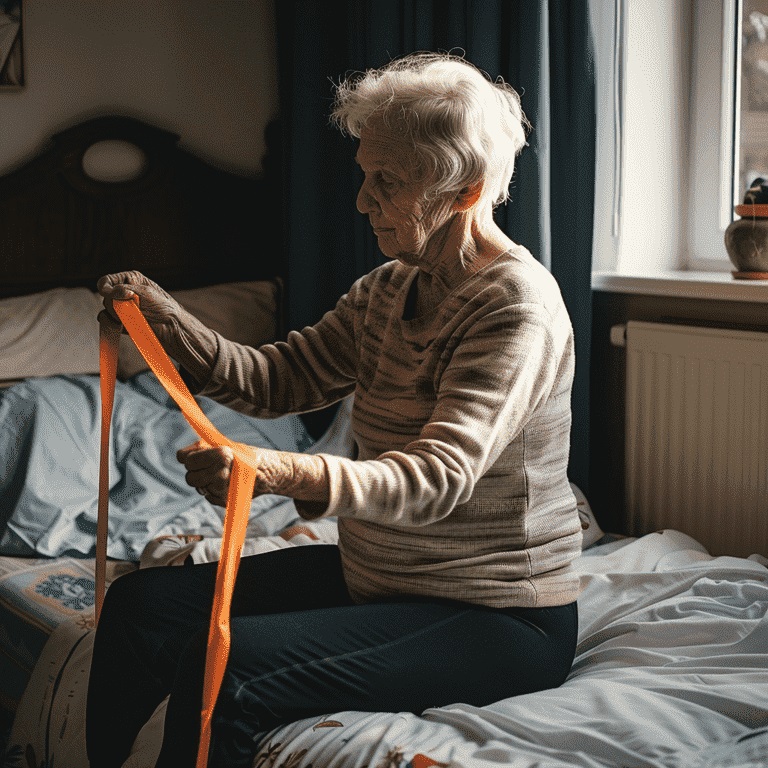
Strengthening Exercises
Strength training is essential for keeping muscle and bone density. This can help prevent falls and improve mobility. Here are some strengthening exercises you can do while lying in bed:
Upper Body Exercises
Arm Raises
Lie on your back with your arms at your sides. Engage your abdominal muscles, raise one arm towards the ceiling, and lower it back down. Repeat with the other arm, alternating sides.
Wall Push-ups
Sit up in bed and place your feet flat on the floor. Scoot your body towards the edge of the bed and place your hands on the wall in front of you, shoulder-width apart. Tighten your core. Lower your body towards the wall. Then, push back to the start.
Bicep Curls with Resistance Bands
Tie a resistance band to the foot of your bed or a sturdy object nearby. Lie on your back and grasp the ends of the band with your palms facing up. Bend your elbows and curl the bands towards your shoulders. Then, slowly release them to the starting position.
Lower Body Exercises
Leg Raises
Lie on your back with your legs extended and your feet flat on the bed. Tighten your abs. Lift one leg slowly to the ceiling. Keep your knees straight. Lower it back down and repeat with the other leg.
Ankle Circles
Lie on your back and extend one leg towards the ceiling. Draw circles with your foot, rotating your ankle in both directions. Repeat with the other leg.
Heel Slides
Lie flat on your back with your feet on the bed and your knees bent. Slide one heel towards your buttocks, keeping your foot on the bed. Slide it back to the starting position, then repeat with the other leg.
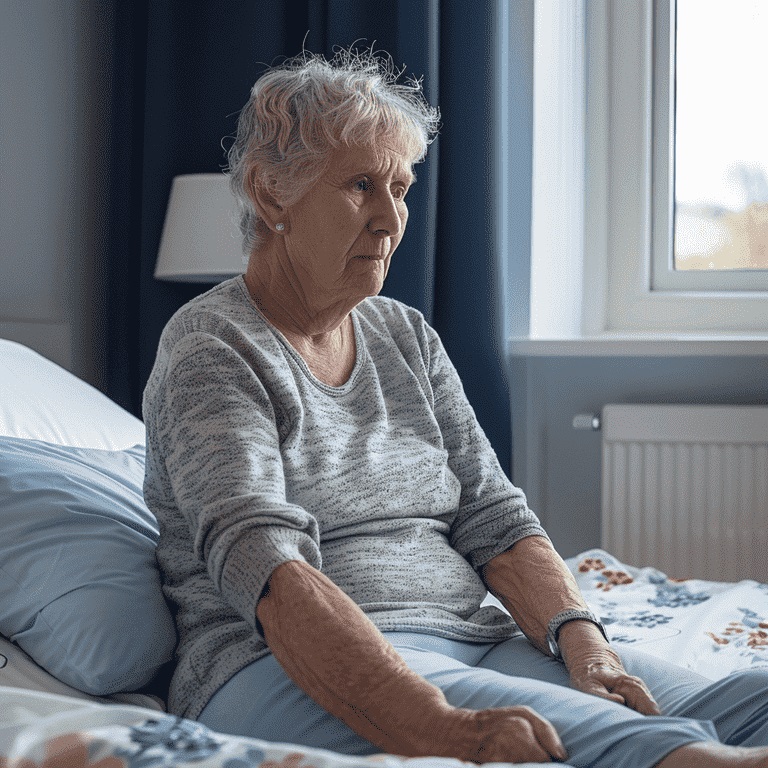
Balance and Coordination Exercises
Improving balance and coordination is crucial for preventing falls and maintaining independence. Here are some exercises you can do while lying in bed:
Seated Exercises
Trunk Twists
Sit up in bed with your feet flat on the floor and your knees bent. Twist your upper body from side to side, keeping your hips facing forward. Use your arms to assist the twist and engage your core muscles.
Marching in Place
Sit up in bed and lift your knees one at a time, mimicking the motion of marching. Engage your abdominal muscles and keep your feet flat on the bed.
Arm Circles
Sit in bed and extend your arms to the sides, forming a T-shape with your body. Make small circles with your arms, rotating them forward and backward.
Standing Exercises (for those able to stand)
Heel-toe Walks
Stand next to your bed and place one foot directly in front of the other, heel to toe. Walk forward in this heel-to-toe pattern. Keep your core tight and your balance steady.
Sideways Stepping
Stand next to your bed and step to the side with one foot, followed by the other. Continue stepping sideways, engaging your core, and maintaining your balance.
Tai Chi Movements
Incorporate gentle Tai Chi movements while standing next to your bed. Focus on slow, controlled movements and deep breathing to improve balance and coordination.
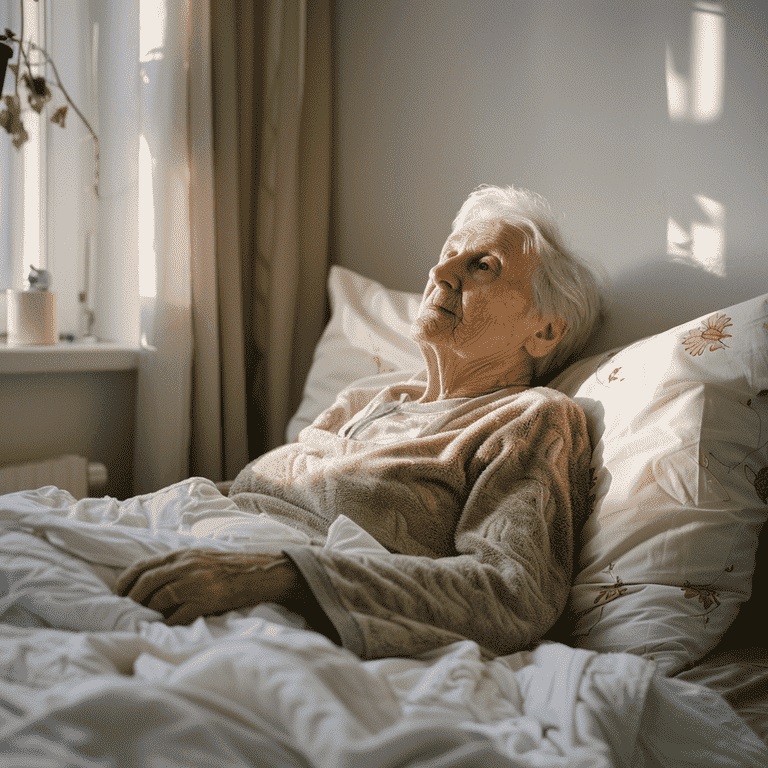
Breathing and Relaxation Exercises
Adding deep breathing and relaxation exercises to your routine can reduce stress. They also improve well-being and promote better sleep. Here are some exercises to try:
Deep Breathing Exercises
Lie on your back with your feet flat on the bed and your hands resting on your abdomen. Inhale deeply through your nose, allowing your abdomen to rise. Exhale slowly through your mouth, feeling your abdomen deflate.
Meditation and Visualization Techniques
Find a comfortable position in bed and close your eyes. Focus on your breath, visualize a peaceful scene, or repeat a calming mantra. Allow your mind to relax and let go of any tension or stress.
Gentle Yoga Poses
Try simple yoga poses while lying in bed, such as the child’s pose or the supine twist. These poses can help promote relaxation and improve flexibility.
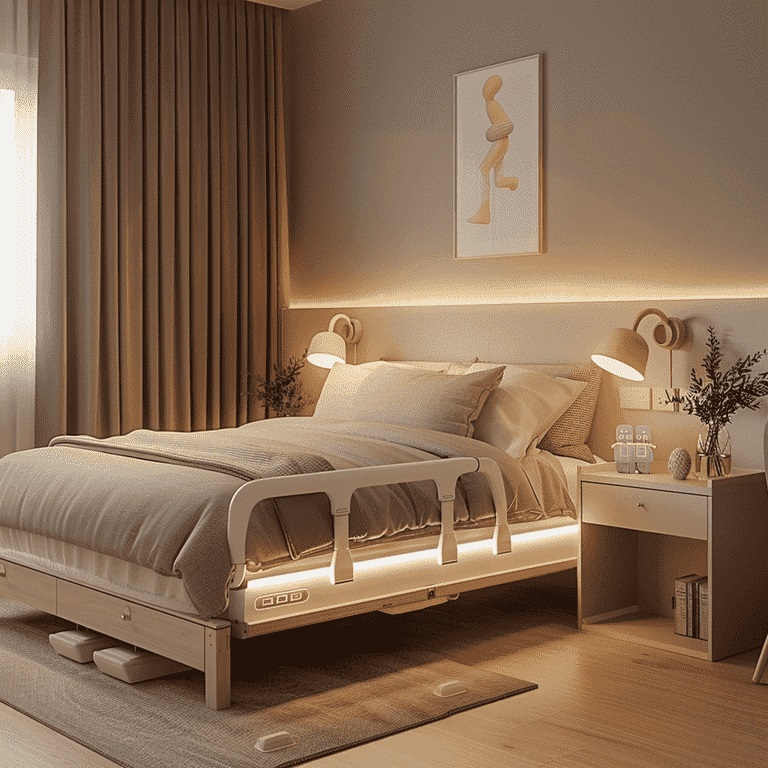
Safety Precautions
Before you start any exercise program, you must consult your healthcare professional. This is especially important if you have pre-existing medical conditions or limitations. They can guide you on which exercises are safe and appropriate for your needs. Remember to modify exercises as needed based on your abilities and limitations. Listen to your body and avoid pushing yourself too far or causing pain or discomfort. Staying hydrated is also important during physical activities. So, drink lots of water before, during, and after your workout.Incorporating Exercises into a Daily Routine
Consistency is vital when it comes to reaping the benefits of regular exercise. Here are some tips for making bed exercises a habit:- Start slowly. Then, increase how long and how hard you exercise as you get more comfortable.
- Set realistic goals and track your progress to stay motivated.
- Involve caregivers or family members in your exercise routine. They can provide support, encouragement, and assistance when needed.
- Pick a set time for your daily exercises. Try to stick to that schedule.
- Incorporate a variety of exercises to target different muscle groups and prevent boredom.
Resources
To supplement your bed exercise program, consider utilizing the following resources:- Instructional videos or illustrations: Many online platforms offer visual guides for bed exercises, which can help with proper form and technique.
- Exercise equipment: Resistance bands, hand weights, or other lightweight equipment can add variety and resistance to your exercises.
- Local or online support groups: Connecting with other elderly individuals with similar goals and challenges can provide motivation and a sense of community.
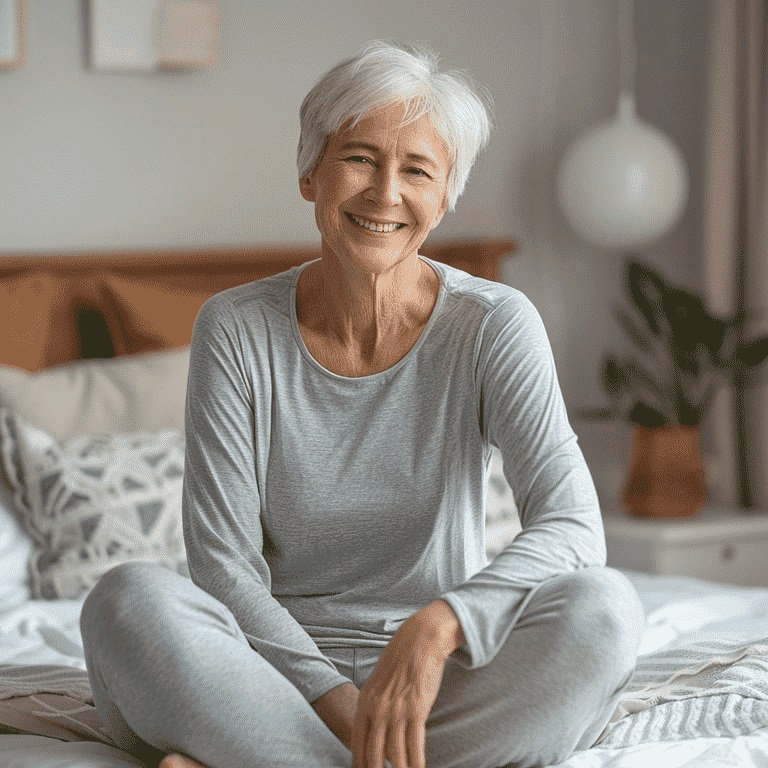
Conclusion
Exercising in bed is practical and effective. It helps elderly people stay active. They can keep their freedom and improve their well-being. Adding stretching, strength, balance, and relaxation exercises to your daily routine can help. They can prevent falls. They also keep your muscles strong and flexible and improve your quality of life.
Remember, start slowly. Consult your healthcare professional before beginning any new exercise program. It’s essential. Be consistent and dedicated. Then, you can reap the many benefits of regular exercise and stay active. You can do this, even from the comfort of your bed.
Frequently Asked Questions
How long should I spend doing bed exercises each day?
Start with 10-15 minute sessions. Increase the duration as you improve. Consistency is key, so aim for a daily routine that fits your capabilities.
Can bed exercises help with joint pain or arthritis?
Gentle bed exercises can help improve joint flexibility and range of motion. This may reduce some joint pain or stiffness from conditions like arthritis. But, you must ask your doctor or therapist for exercises tailored to you.
What should I do if I experience pain or discomfort during an exercise?
Stop the exercise immediately and listen to your body. Pain or great discomfort means you may push too hard or do the exercise wrong. Consult your healthcare provider for guidance on proper form and modifications.
Are there any exercises that can help improve circulation?
Yes, exercises involve gentle leg movements. These include leg raises, ankle circles, and heel slides. They can help improve blood flow in the lower legs. This reduces the risk of blood clots and promotes better circulation.
How can I make bed exercises more challenging as I get stronger?
As you progress, you can raise the difficulty. You can do this by adding resistance bands. You can also use light weights, if approved by your doctor. You can also do it by doing more repetitions of each exercise.
Can bed exercises help with incontinence issues?
Some exercises, like pelvic floor exercises (Kegel exercises), can strengthen the muscles. They support bladder control. They may improve incontinence. Consult a physical therapist or your healthcare provider for specific exercises and techniques.
Is it safe to do bed exercises if I have osteoporosis?
People with osteoporosis should ask their doctor or a physical therapist for advice. They need to learn which exercises are safe and right for their condition. The doctor may recommend low-impact exercises. They improve strength and balance. But, avoid high-impact or weight-bearing exercises.
Can bed exercises help improve my balance and coordination?
Adding balance and coordination exercises helps. These include trunk twists and marching in place. They can improve your stability and cut the risk of falls.
How can I stay motivated to continue my bed exercise routine?
Setting realistic goals. Track your progress. Involve family or caregivers for support. Vary your exercises. These steps can keep you motivated and engaged. Also, celebrate small victories. Focus on the benefits of more strength, flexibility, and independence.
Glossary
Abdominal Muscles: The group of muscles that form the front wall of the abdomen, including the rectus abdominis, external and internal obliques, and transverse abdominis.
Balance: The ability to maintain the body’s center of mass over its base of support, essential for preventing falls and maintaining stability during movement.
Blood Clots: A thickened, semi-solid mass of blood that can form in the veins or arteries, potentially leading to life-threatening conditions such as stroke or pulmonary embolism.
Coordination: The ability to use different body parts together smoothly and efficiently for movement and action.
Exercise Program: A structured plan that outlines the specific exercises, duration, intensity, and frequency of physical activities designed to achieve particular fitness goals.
Exercise Routine: A regular and consistent pattern of engaging in physical activities or exercises as part of a fitness regimen.
Feet Flat: A position where the entire sole is in contact with the surface, providing a stable support base for various exercises.
Flexibility: The ability of a joint or muscle to move through its full range of motion.
Physical Activities: Any bodily movement produced by the contraction of skeletal muscles that increases energy expenditure.
Physical Therapist: A healthcare professional specializing in evaluating, diagnosing, and treating individuals with physical impairments or disabilities through exercise, therapy, and education.
Range of Motion: The full movement potential of a joint, muscle, or body part, typically measured in degrees.
Regular Exercise: Regularly engaging in physical activities or exercises consistently and frequently, typically several times per week.
Starting Position: The initial body position or stance from which an exercise or movement begins.
Strength Training: A type of physical exercise focusing on increasing muscle strength, endurance, and power through resistance or weight-bearing activities.
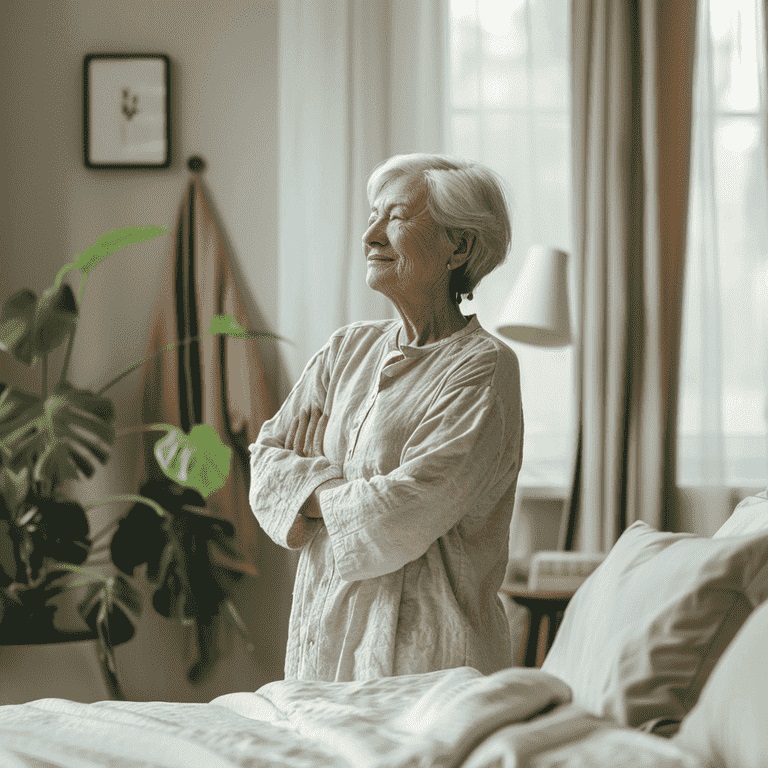
What Next?
We’ve provided a detailed bed exercise guide. Also, Grand Strand Comfort Care offers many in-home care services. These services support the elderly in the Myrtle Beach, South Carolina area. Our caregivers dedicate themselves. They are committed to helping seniors maintain their independence, dignity, and quality of life. They do this in the comfort of their own homes. Our services include:- Light housekeeping and laundry assistance
- Meal preparation and nutritional support
- Personal care, such as bathing and grooming
- Transportation to appointments and errands
- Companionship and social engagement
- Medication reminders and management
